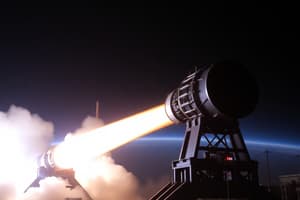Podcast
Questions and Answers
What is the primary function of rocket propulsion in space missions?
What is the primary function of rocket propulsion in space missions?
- Creating a protective shield around the spacecraft
- Generating oxygen for breathing
- Converting chemical energy into kinetic energy (correct)
- Generating electrical energy
Which fuel type provides high thrust due to its low molecular weight in rocket propulsion?
Which fuel type provides high thrust due to its low molecular weight in rocket propulsion?
- Liquid hydrogen (correct)
- Methane combinations
- Liquified natural gas (LNG)
- Solid propellants
What advantage do solid propellant rockets offer over other types in terms of ignition?
What advantage do solid propellant rockets offer over other types in terms of ignition?
- They produce less pollution
- They can be reused multiple times
- They are more cost-effective
- They can ignite spontaneously without external power sources (correct)
Why do solid propellant rockets have limited scalability compared to other options in rocket propulsion?
Why do solid propellant rockets have limited scalability compared to other options in rocket propulsion?
Which type of fuel used in spacecraft combines efficiently with oxygen to produce water vapor upon burning?
Which type of fuel used in spacecraft combines efficiently with oxygen to produce water vapor upon burning?
What critical parameter measures how effectively an engine consumes propellant per unit of mass accelerated?
What critical parameter measures how effectively an engine consumes propellant per unit of mass accelerated?
Which type of rocket propulsion technology offers exceptional advantages in terms of fuel economy and operational longevity?
Which type of rocket propulsion technology offers exceptional advantages in terms of fuel economy and operational longevity?
What does the mass ratio (MR) of a rocket stage reflect?
What does the mass ratio (MR) of a rocket stage reflect?
Which parameter quantifies the amount of force exerted on a rocket during takeoff?
Which parameter quantifies the amount of force exerted on a rocket during takeoff?
What is the purpose of booster engines in a rocket?
What is the purpose of booster engines in a rocket?
Study Notes
Space Missions and Rocket Propulsion
Driving vehicles through our atmosphere is challenging enough, but when we venture into the vastness of space, it becomes infinitely more complex. At the heart of sending probes, satellites, and humans beyond Earth's orbit lies one of engineering's greatest achievements – rocket propulsion. This foundational aspect of space exploration has transformed from mere dreaming to reality over decades, paving the way for countless scientific breakthroughs, technological advancements, and groundbreaking discoveries.
Rockets work by converting chemical energy stored within their fuel into kinetic energy responsible for propelling them upward and outward. Rockets come with various design choices to maximize performance while minimizing cost, size, and weight limitations — all crucial factors in space travel.
Fuel Types and Combustion Process
Spacecraft rely primarily on three types of fuels: liquid hydrogen, solid propellants, and cryogenic propellants like liquified natural gas (LNG) & methane combinations. Liquid hydrogen provides high thrust due to its low molecular weight and combines efficiently with oxygen to produce water vapor upon burning. Solid propellant rockets offer simple integration and can ignite spontaneously without external power sources. However, they cannot adjust their momentum once launched and have limited scalability compared to other options. In contrast, cryogenically cooled propellants, such as supercooled liquid hydrogen, require specialized tanks to maintain their extremely low temperatures but deliver excellent specific impulses and overall efficiency.
The propulsive force generated from these fuels accelerates crafts via the efficient combustion process, resulting in exhaust gases expelled rearwards at high velocities creating thrust. A rocket engine typically integrates multiple stages featuring smaller engines called boosters designed to carry larger payloads farther before they burn out and detach.
Key Parameters of Rocket Performance
Three critical parameters define a rocket's potential:
- Specific Impulse (Isp): Represents how effectively the engine consumes propellant per unit of mass accelerated, measured in seconds. Higher Isp values indicate better efficiency. Conventional rockets possess an Isp between 280–320 s; however, advanced technologies like nuclear thermal rockets could potentially attain 900 s.
- Thrust: Quantifies the amount of force exerted on a vehicle during takeoff, measured in Newton or pound-force units. Generally speaking, thrust increases proportionately with the size of a rocket launcher; hence, large launch systems yield substantially higher forces.
- Mass ratio (MR): Reflects the relationship between initial and final masses of a rocket stage, indicating how much payload a particular mass of rocket can send into space. High MR values suggest superior lifting capability whereas lower ratios result in less favorable payload capacity.
These metrics play a significant role in determining whether a given space mission succeeds or fails based on a combination of minimal waste, optimal efficiency, and maximum payload capabilities.
Advances in Rocket Technology
Since humanity first set foot onto lunar soil, engineers continually seek ways to improve rocket designs and propulsion techniques that expand the reach of human endeavors. For instance, reusable Launch Vehicle (RLV) technology aims to reduce costs associated with traditional expendable launch systems by enabling components such as booster rockets and upper stages to return safely back to Earth after flight, ready for immediate refurbishment and relaunch. Furthermore, electric propulsion using ion thrusters offers exceptional advantages in terms of fuel economy and operational longevity, ideal for deep space missions where frequent course corrections or sustained propulsion are essential.
In conclusion, understanding rocket propulsion forms the bedrock foundation to comprehending modern-day space missions. By exploring this vital field further, humankind continues pushing boundaries ever deeper into the cosmos, making new astronomical leaps possible every day.
Studying That Suits You
Use AI to generate personalized quizzes and flashcards to suit your learning preferences.
Description
Explore the essential concepts behind space missions and rocket propulsion, from the different fuel types to key parameters impacting rocket performance and advances in rocket technology. Learn how rocket engines work, the importance of specific impulse, thrust, and mass ratio, and the latest advancements shaping the future of space exploration.





